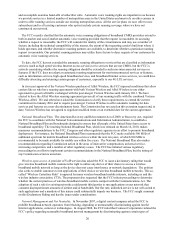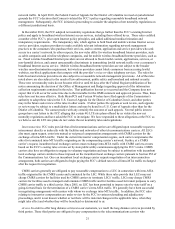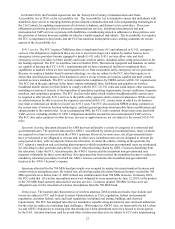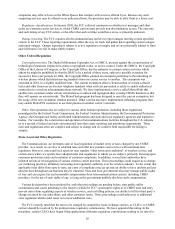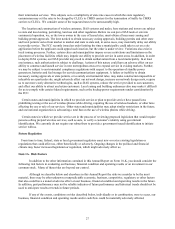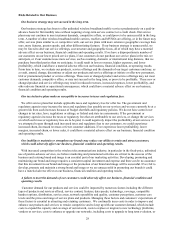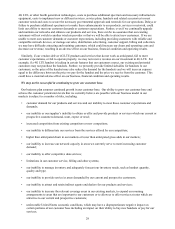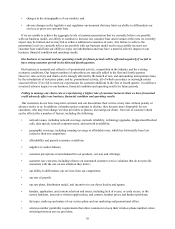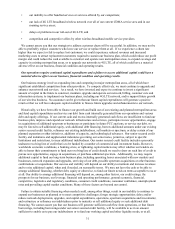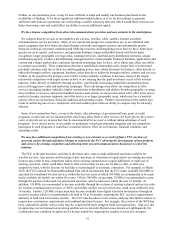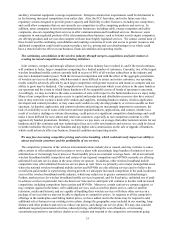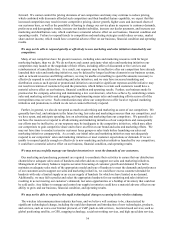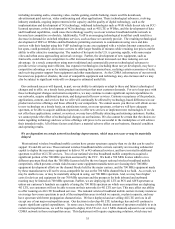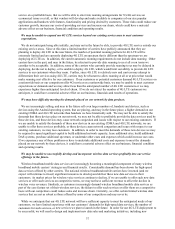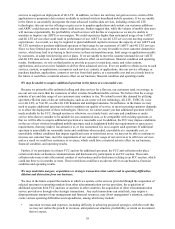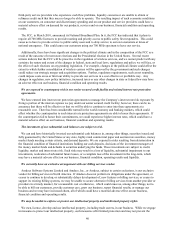Metro PCS 2010 Annual Report Download - page 40
Download and view the complete annual report
Please find page 40 of the 2010 Metro PCS annual report below. You can navigate through the pages in the report by either clicking on the pages listed below, or by using the keyword search tool below to find specific information within the annual report. 30
• changes in the demographics of our markets; and
• adverse changes in the legislative and regulatory environment that may limit our ability to differentiate our
services or grow our customer base.
If we are unable to achieve the aggregate levels of customer penetration that we currently believe are possible
with our business model, our ability to continue to increase our customer base and revenues at the rates we currently
expect may be limited and we may fail to achieve additional economies of scale. Any failure to achieve the
penetration levels we currently believe are possible with our business model and to successfully increase our
customer base could limit our ability to repay our indebtedness and may have a material adverse impact on our
business, financial condition and operating results.
Our business is seasonal and our operating results for future periods will be affected negatively if we fail to
have strong customer growth in the first and fourth quarters.
Our business is seasonal and reflective of promotional activity, competition in the industry and the existing
economic conditions. Our largest numbers of subscribers are typically added in the first and fourth quarters.
However, sales activity and churn can be strongly affected by the launch of new and surrounding metropolitan areas,
by the introduction of new price plans, and by, promotional activity, all of which can reduce or outweigh certain
seasonal effects. If we fail to meet our expectations for customer additions in the first or fourth quarter, it could have
a material adverse impact on our business, financial condition and operating results for future periods.
Failing to manage our churn rate or experiencing a higher rate of customer turnover than we have forecasted
could adversely affect our business, financial condition and operating results.
Our customers do not have long-term contracts and can discontinue their service at any time without penalty or
advance notice to us. In addition, as handset prices continue to decline, they become more disposable for our
customers, who may then change wireless providers or phones, increasing our churn. Our rate of customer churn
can be affected by a number of factors, including the following:
• network issues, including network coverage, network reliability, technology upgrades, dropped and blocked
calls, data speeds, network responsiveness, and network availability;
• geographic coverage, including roaming coverage at affordable rates, which has historically been less
extensive than our competitors;
• affordability and general economic conditions;
• supplier or vendor failures;
• customer perceptions of and demand for our products, services and offerings;
• customer care concerns, including reliance on automated customer service solutions that do not provide
customers with the one on one attention they desire;
• our ability to differentiate our services from our competitors;
• our rate of growth;
• our rate plans, distribution model, and incentives to our direct dealers and agents;
• handset, application, and content selection and issues, including lack of access, or early access, to the
newest handsets, innovative wireless applications, and content, handset prices and handset problems;
• the types, make-up and nature of our service plans and our marketing and promotional offers;
• wireless number portability requirements that allow customers to keep their wireless phone numbers when
switching between service providers;


